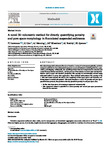A novel 3D volumetric method for directly quantifying porosity and pore space morphology in flocculated suspended sediments
| dc.contributor.author | Lawrence, TJ | |
| dc.contributor.author | Carr, SJ | |
| dc.contributor.author | Manning, AJ | |
| dc.contributor.author | Wheatland, JAT | |
| dc.contributor.author | Bushby, AJ | |
| dc.contributor.author | Spencer, KL | |
| dc.date.accessioned | 2023-02-27T12:15:14Z | |
| dc.date.issued | 2023 | |
| dc.identifier.issn | 2215-0161 | |
| dc.identifier.issn | 2215-0161 | |
| dc.identifier.other | 101975 | |
| dc.identifier.uri | http://hdl.handle.net/10026.1/20501 | |
| dc.description.abstract |
Flocculated suspended sediments (flocs) are found in a variety of environments globally, and their transport and behavior bear substantial importance to several industries including fisheries, aquaculture, and shipping. Additionally, the modelling of their behavior is important for estuarine and coastal flood prediction and defence, and the process of flocculation occurs in other unrelated industries such as paper and chemical production. Floc porosity is conventionally assessed using inferential indirect or proxy data approaches. These methods underestimate floc porosity % by c. 30% and cannot measure the micro-scale complexity of these pore spaces and networks, rendering inputs to models sub-optimal. This study introduces a novel 3D porosity and pore space quantification protocol, that produces directly quantified porosity % and pore space data.•3D floc data from micro-CT scanning is segmented volumetrically•This segmented volume is quantified to extract porosity and several pore space parameters from the floc structure. | |
| dc.format.extent | 101975-101975 | |
| dc.format.medium | Electronic-eCollection | |
| dc.language | en | |
| dc.language.iso | eng | |
| dc.publisher | Elsevier | |
| dc.subject | 3D Quantification of Porosity and Pore Space | |
| dc.subject | in Flocs | |
| dc.subject | Porosity quantification | |
| dc.subject | Flocculation | |
| dc.subject | Estuary sediments | |
| dc.subject | Pore space | |
| dc.title | A novel 3D volumetric method for directly quantifying porosity and pore space morphology in flocculated suspended sediments | |
| dc.type | journal-article | |
| dc.type | Article | |
| plymouth.author-url | https://www.ncbi.nlm.nih.gov/pubmed/36636283 | |
| plymouth.volume | 10 | |
| plymouth.publication-status | Published | |
| plymouth.journal | MethodsX | |
| dc.identifier.doi | 10.1016/j.mex.2022.101975 | |
| plymouth.organisational-group | /Plymouth | |
| plymouth.organisational-group | /Plymouth/Faculty of Science and Engineering | |
| plymouth.organisational-group | /Plymouth/Faculty of Science and Engineering/School of Biological and Marine Sciences | |
| plymouth.organisational-group | /Plymouth/REF 2021 Researchers by UoA | |
| plymouth.organisational-group | /Plymouth/REF 2021 Researchers by UoA/UoA07 Earth Systems and Environmental Sciences | |
| plymouth.organisational-group | /Plymouth/Research Groups | |
| plymouth.organisational-group | /Plymouth/Research Groups/Marine Institute | |
| plymouth.organisational-group | /Plymouth/Users by role | |
| plymouth.organisational-group | /Plymouth/Users by role/Academics | |
| dc.publisher.place | Netherlands | |
| dcterms.dateAccepted | 2022-12-14 | |
| dc.rights.embargodate | 2023-2-28 | |
| dc.identifier.eissn | 2215-0161 | |
| dc.rights.embargoperiod | Not known | |
| rioxxterms.versionofrecord | 10.1016/j.mex.2022.101975 | |
| rioxxterms.licenseref.uri | http://www.rioxx.net/licenses/all-rights-reserved | |
| rioxxterms.licenseref.startdate | 2023 | |
| rioxxterms.type | Journal Article/Review |


